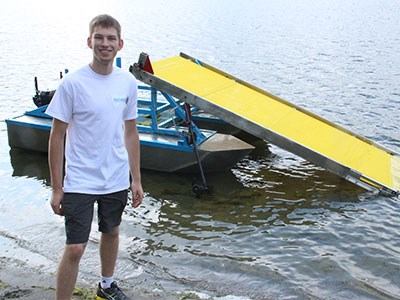There aren't too many 19-year-olds who can call themselves CEO of a robotics company.
But Laurentian University student Colin Roos of Sudbury now holds that title – thanks to a new company he started with some former classmates and friends, called Northern Ontario Robotic Solutions and Equipment, or NORSE for short.
Roos and his friend Matteo Neville were founding members of Lo-Ellen Park Secondary School's robotics team.
Along with team members Xuan Han, Edmund Noble and Alex Bertrand, they made it to the World Robotics Championships for three consecutive years – and placed as high as 12th in their category, out of 100 teams.
Even though the friends went their separate ways after high school – to different universities in Ontario – they decided to turn their common interest in robotics into a business.
“I've always been into solving problems with my hands,” said Roos.
In September, the team unveiled the company's first robot, built to collect blue-green algae from lakes.
The robot, called ODIN, after the father of all Norse gods, and ruler of Asgard, is about the size of a paddle boat, and includes a yellow conveyor belt that dips into the water diagonally.
ODIN is controlled remotely with a Logitech video game controller hooked up to a laptop. The laptop has a radio antenna that has a range nearing 10-kilometres.
The operator can manoeuvre the robot around a lake, where the conveyor belt scoops up blue-green algae – which is sometimes toxic, and can irritate the skin or, in some cases, can cause serious harm if ingested.
The robot is far more agile and affordable than the large vehicles currently used to clean blue-green algae blooms, Roos said.
The larger machines also require several operators on board, while ODIN can be controlled by one person on the shore.
Roos said in the long term they would like to make the robot fully automated, much like iRobot's Roomba robotic vacuum cleaner.
To reach their first public demonstration, NORSE had a little help along the way.
Roos said people didn't take them seriously at first because they were so young.
But they eventually got in touch with Kyle McCall, co-ordinator at the Northern Centre for Advanced Technology (NORCAT) Innovation Mill.
“When we saw a bunch of young, entrepreneurial and innovative kids come to our door, and they had this really neat idea, we said, 'Yes, absolutely, we can help you,'” McCall said.
Through the Innovation Mill, McCall was able to connect the NORSE team with business mentors, who helped them execute their plan.
NORCAT was also able to get the team the capital funding needed to build ODIN, and supplied some shop space for the first prototype.
The connections they fostered with NORCAT, said Roos, also gave them more legitimacy and helped open some doors.
NORSE later connected with Charles Ramcharan, a Laurentian biology professor, who taught them how algae blooms form, and what they should look for when cleaning a lake.
Ramcharan had worked on his own device to clean lakes, but later decided to share what he had learned with NORSE.
“It's neat how we've converged on the same ideas,” he said.
Roos said it’s a difficult balance to be a full-time student and run a new company at the same time. But it hasn't deterred him from having big plans for NORSE.
He said he wants to be the go-to robotics contractor in Sudbury, to provide innovative solutions for mining and environmental applications.




